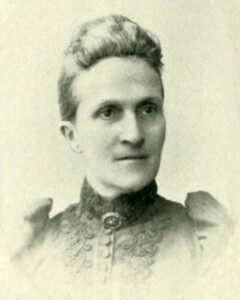The Atchison College Institute was founded in September 1870 by Mrs. Harriet E. Monroe, its proprietor and president. A private school, it was a cooperative enterprise of instructors, and she served as the first principal. She had nine students when she started her school and subsequently increased her enrollment to 300 within three years. The school first opened in a little building on Fourth Street and was afterward conducted in the unfinished part of the Kansas Avenue Methodist Episcopal Church.
In November 1871, the first building upon the present site of the Institute, the northwest corner of Third Street and Kansas Avenue, was occupied. A wing was added in 1876, and the large brick building in 1879. The location of the Institute buildings was high, healthful, and beautiful, the property at present representing a valuation of $25,000.
Afterward, many important additions were made, and the Institute became one of the state’s most well-known private educational institutions. She received no bonus or assistance from the city, county, state, church, or individuals.
Its musical department alone numbered 70, and its art department 50. It had no superior in the Missouri Valley for these two specialties.
She also conducted kindergarten, primary, intermediate, and academic grades. Also, a collegiate department consisted of preparatory, scientific, classical, and literary courses and standard and commercial courses. She had 13 teachers. Her vocational department covered all the arts of domestic economy and domestic science, before which she employed the most eminent women in their special lines to deliver lectures.
“The Institute is located on Kansas Avenue between Third and Fourth Streets. The buildings are of stone, one 25 by 50 feet and the other 20 by 30 feet, both three stories high. It has five well-appointed recitation rooms and 16 rooms to accommodate boarders from abroad. During the past six months, 200 students have been enrolled, with an average attendance in the various departments of 144.”
— Kansas Monthly, June 1879
Its course of Belles Letters was unique and original and commended itself to the judgment of thoughtful parents. It was designed as a postgraduate course for ladies and women who, later in life, had the time and means to cultivate their mental abilities. It realized that while higher mathematics was always beneficial, it was less so in women’s education than in good domestic and literary training. During the course of two years, nearly 100 volumes, including the classics of all languages, were read and discussed for training both as to matter and manner of conversation.
The course was divided into four chapters of divisions, including a chapter on Language, a Domestic Chapter, a Chapter on Literature, and a Chapter on Accomplishment. The most eminent ladies of the West lectured before these classes. They showed that they considered no woman’s education complete who did not know how to conduct a household, care for the minds and bodies committed to her care, and prepare citizens for the republic. The next was an extensive course in the histories and literature of different countries, the history of art and artists, music and musicians, architecture and architects, besides the discussion of 40 books on those subjects. The chapter on accomplishments consisted of music to the seventh grade, conversation as a science and art, oil and watercolored painting, and general decorative art. The substitute for painting or music was cookery as an art.
Mrs. Monroe was a remarkable woman who was highly educated, a lady of refinement and culture, and spent much time on the lecture platform. In 1885, her health was failing, and she was compelled to give up the school. During her 13 years at the Atchison College Institute, in that school, she had 2,621 students under her charge. She then moved to Washington, D.C.
Some years after the Atchison College Institute closed, Professor Flint conducted a Latin school there, which was well attended. He was succeeded by Professor Foot, and as an outgrowth of these two schools, Misses Helen and Abigail Scofield opened a preparatory school and successfully conducted it for several years when they were succeeded by Miss Mary Walton, who ran her school in the building owned by Mrs. J.W. Parker, on Laramie street, between Third and Fourth Streets.
©Kathy Alexander/Legends of Kansas, December 2023.
Also See:
Harriet Earhart Monroe – Educator
One-Room, Country, & Historic Schools of Atchison County
Sources:
Blackmar, Frank W.; Kansas: A Cyclopedia of State History, Vol I; Standard Publishing Company, Chicago, IL 1912.
Cutler, William G; History of Kansas; A. T. Andreas, Chicago, IL, 1883.
Kansas State Historical Society, The Columbian History of Education in Kansas, Hamilton Printing Company, Topeka, KS, 1893
Wikipedia

